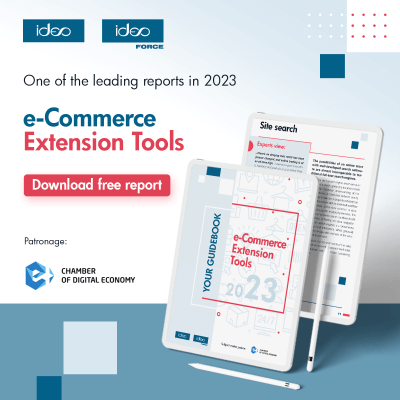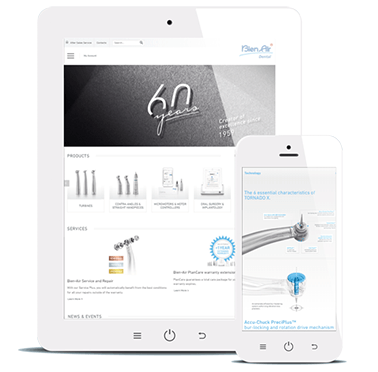As many as 10-40% of people visiting an online store use the product search engine to navigate through the website. In its study, Prefixbox went a step further and found that up to 40-80% of purchases are generated by e-shop search tools.
The daily contact of Internet users with powerful search engines, such as Google, has shaped their expectations towards the search mechanisms that they deal with in online stores. It should be fast, efficient and straight to the point.
Search engines have a huge potential for e-shops, but only properly tailored to the needs of a given business can bring measurable results. Learn about the possibilities offered by product search engines for e-commerce, their functions and technologies.

What is, in fact, the product finder in an online store?
As the first association with searching in an online store, the image of the text field in which we enter the query appears in our head. In fact, from the point of view of the creators of the store, it is much more than a box to be supplemented with a search term. However, a local search engine in an online store is a tool that can be much more integrated with the website of a given e-store.
A search tool appropriately tailored to the needs of the industry, the width and depth of the assortment is responsible for providing the customer with the desired results with maximum accuracy. This includes:
- searching using the search engine (field for entering queries),
- faceted search (using defined filters),
- product rankings (displaying results in a hierarchy subordinated to the sorting criteria),
- database of accepted synonyms
The first YES - reduction of empty results pages
People who are looking for one and the same thing will enter their query in many ways. One will describe the product in detail, the other will omit Polish characters, the third will use the customary name, and so on. We get used to the realities in which a potential customer expects the store to understand its intentions and communication methods more and more.
If the search engine is unable to process the entered query, blank results pages appear.
Errors and synonyms tolerance
As a result of the appearance of the 'zero result page', customer satisfaction with the purchasing experience decreases. Research shows that 20% of search engine users re-enter their query as soon as they enter the first one, and 21% leave immediately after the first failed attempt. One of the solutions for this type of situation is to match high tolerance to errors, phonetic notations and synonyms of key phrases used in the description of the product or product category.
Most of the available tools allow the store administrator, for example, to create a database of accepted synonyms. Modern solutions use Machine Learning, thanks to which our search engine can build such a database on its own, and thus remember and recognize new synonyms even more effectively.

NLP (Natural Language Processing)
An additional problem arises when a word with several meanings is used in the query. Understanding the intentions or complex queries like those that we would ask a service employee in a brick-and-mortar store is often a problem for search engines based on key phrases.
Natural Language Processing is a method of semantic query processing used in modern search engines. It allows you to search in full sentences using the natural language we use every day, as opposed to entering queries based on key phrases.
Due to NLP, it is the search engine that has the task of "extracting" the intention from the entered query, saving the Client's effort on coming up with a phrase scheme that will fulfill its task.
 “Others also searched” - as alternatives for missing product
“Others also searched” - as alternatives for missing product
Achieving customer satisfaction with the delivered results is a challenge, the implementation of which is spread over time. It is impossible to eliminate blank pages of results 100% if, for example, the entered query is extremely unusual or the product you are looking for has sold out or has been withdrawn from sale.
The situation may be alleviated by replacing the crude message about the lack of appropriate results with proposals for alternatives to the original search object. If the store platform is integrated with the suppliers' warehouse systems, you can also show the product with information about the planned availability date.
A proper product search engine enables detailed and transparent definition of groups of products similar thematically by category or individual characteristics. In that, instead of a gaping blank page, we provide the customer with related, alternative products before continuing to search in another store.
The second YES - intuitive customer journey
Search engine users are a group of customers with high purchasing potential. The probability of placing an order by such a customer is 5-6 times higher than for a user who simply browses product catalogs without a specific scheme.
Every e-commerce manager aims to increase sales, conversion and overall development of the online store. Since you already know that the group using the search engine is an extremely important segment of customers, it is worth comprehensively optimizing the functions available to them.
Faceted search and sorting capabilities
Faceted navigation in an online store is the application of specific filters to products, which are based on their various features. This function is definitely useful in websites with an extensive assortment, and in the case of multi-sector giants - necessary.
For the client, it is a helpful tool both for filtering overly general search results and for people navigating directly through subsequent product categories.

Sorting is another option in the search tool that allows the customers to adjust the view of available filtered products according to defined hierarchies. Most often it is the relevance, price or popularity of the offered objects.
Displaying the quantity of products found
The information about the number of products matched to the query is not an obvious element of displaying the results. Online stores are introducing such a feature more and more often in order to provide the perfect customer shopping experience, but many still lack it.
Information about the depth of the entire catalog placed at its beginning is the starting point for the client in subsequent activities. For the comprehensive use of the potential of such a function, we can use the view of the number of available variants in each category at the stage of filtering the results.
First sight and 27 characters
Placing the search engine field in a visible place is one of the most basic principles in designing the implementation of a search engine to an online store. Most often, the inquiry box should have its own, separate place at the very top of the storefront, near the navigation elements.
Size also matters in this case. Each customer searches differently and it is worth preparing the search engine to accept longer phrases of the query in such a way that their content does not disappear out of the user's sight.
The optimized search field should contain a minimum of 27 characters, which, according to research, is 70% of queries entered in online stores.
Autocomplete
In the search engine, we can use the practical autocomplete of the entered phrase function. After entering enough letters to recognize probable words, the tool suggests their ending or the completion of the entire phrase based on the possibilities defined in the database, often with a convenient hint. In that, the customer can determine on an ongoing basis whether the results meet their needs or whether the entered query should be modified.
Depending on the implemented tool, some offer the possibility to preview the results. A list or several tiles with sample search results for a given phrase develops under the search field before it is confirmed. From there, the client can go directly to the offer he is interested in without the need to search the entire set of results.
Search between categories
Often, medium and larger online stores have additional content elements on the website. These can be industry blogs, subpages of documentation, regulations, or news from the company's life.
A convenient solution in this case is to enable searching also for individual categories of subpages. In this way, customers will find the information or products they are looking for faster, as well as additional content about them.
The third YES - modern future of product finders
Searchandising
More and more consumer groups are permanently transferring their daily shopping habits to the Internet, which continuously motivates and inspires e-commerce "players". This is a good time for e-commerce managers to analyze proven actions driving offline sales and turn them into profitable online sales solutions.
One of them is searchandising, i.e. merchandising in the e-commerce version. It includes the process of planning the results view with the intention of strengthening interest in a given product and / or increasing sales in a given area.

Searchandising is a sales and marketing tool to promote selected products and organize the hierarchy in the results view. For example, in a clothing store on request for jackets:
- in the summer, you can plan to primary display seasonal novelties
- in the autumn-winter period, you can distinguish winter products, or discounted products from the summer period, but also remainders from the previous season sale - depending on the store's policy.
The use of searchandising requires ongoing monitoring of the effects in order to properly modify and improve the introduced rules.
Personalization
In e-commerce, personalization is much more than just matching ads and other activities to a specific customer. Personalization may also refer to adjusting individual elements appearing on the shopping path to the customer's needs.
Personalization in an online store can be based on various factors.Using the search engine for this purpose, the ground zero is, in the simplest terms, the search history, from which you can extract the necessary information and adjust specific actions based on it.
The specific behavior of consumers when using the search engine and faceted navigation makes it possible to distinguish consumers visiting the store from each other. By analyzing their path on the website, you can see patterns of their demeanour and identify certain characteristic groups among them.
At least 60% of e-shoppers expect matched search results, and this number continues to grow. Properly held personalization shows your clients that you understand their needs and desires, and most importantly, that you try to respond to them.
By presenting products that the client is more likely to be interested in, you also increase the chance of increasing sales.
Observing trends
The information provided by users of the search engine in your store is also valuable in a wider range of use. The ongoing analysis of consumer behavior, the way of formulating inquiries, and especially their content, supplies you with a valuable tool for monitoring trends.
It is worth mentioning that such data gains value because of its accuracy. Purchasing trends that you observe shaping through the inquiries in your search engine, are exactly what your customers expect at a given time. You do not have to filter out unnecessary data about trends appearing in the entire industry in which you operate, because the current expectations of the community of your regular and potential customers visiting the store are already known.
Meeting the periodic needs of consumers, caused by a temporary increase in the popularity of the product, means fitting into the real-time market. In this way, you successively gain the trust and loyalty of customers, by showing them that you can quickly respond to their needs.
ML and AI era
Artificial Intelligence is an area of computer science that allows systems to "learn" from and adapt to input data. The product search engine based on artificial intelligence learns from data about users in order to provide them with the most accurate and relevant results.
The process of self-learning the search engine is possible thanks to machine learning (ML) technology. This is done in real time by matching results in the background as the person views more products. The basis for identifying the right actions are factors programmed in AI, such as the person's previous purchases, frequent spelling mistakes, or the intentions behind the query language (NLP).
The potential of artificial intelligence is slowly being implemented by successive search engine manufacturers. Its use supports especially processes such as personalization or natural language processing.
In the case of NLP, this is a big step forward because words with subjective feelings for different consumers have often been difficult for IT architects. For example, the use of the words "cheap" or "expensive", thanks to an intelligent search engine, can be properly interpreted on the basis of learned and adapted patterns of user behavior.
Many factors can be introduced into the tool's functions manually, but the role of AI is to imitate them in practice without the need for additional coding or human monitoring. Intelligent search engines have the ability to enhance elements of their functionality in terms of accuracy or relevance as well as improve and learn over time like a human being.
Summary
A search engine in an online store may seem to be the basic element of a sales website, but from the implementation point of view it is not so obvious. There are many functionalities available, the emerging technologies raise the bar, and yet a poorly optimized tool can really have a negative impact on Customer Experience and, as a result, scare potential customers.
To maximize the potential of the product finder, you must choose the tool that meets your and your customers' expectations.
Benefits of an optimized product finder
- Increased relevance of results for queries,
- Translating into customer loyalty and commitment,
- Raised quality of CX (Customer Experience),
- Effective implementation of business goals,
- Conversion increment,
- Efficient upselling,
- Increased sales effectiveness.



 As mentioned above, clients from all over the world rate our comprehensive approach to project implementation and business consulting, which is why Clutch has considered uss a leading eCommerce Software Development Team in Poland. That is, however, not all.
As mentioned above, clients from all over the world rate our comprehensive approach to project implementation and business consulting, which is why Clutch has considered uss a leading eCommerce Software Development Team in Poland. That is, however, not all. In our daily work, we help to develop our clients' businesses. Their trust and effective cooperation make us grow as well. In January, 2022, the new edition of the Forbes Diamond Award report was published and we were proud to be listed among the fastest-growing Polish enterprises in this prestigious report. And as we help to develop our clients' businesses by doing our utmost best, their thrust and cooperation mean a lot. Indeed, we will only continue to grow together!
In our daily work, we help to develop our clients' businesses. Their trust and effective cooperation make us grow as well. In January, 2022, the new edition of the Forbes Diamond Award report was published and we were proud to be listed among the fastest-growing Polish enterprises in this prestigious report. And as we help to develop our clients' businesses by doing our utmost best, their thrust and cooperation mean a lot. Indeed, we will only continue to grow together!













